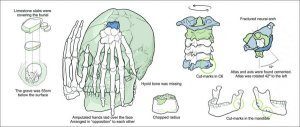
A 9,000 year-old case of human decapitation has been found in the rock shelter of Lapa do Santo in Brazil, according to a study* published September 23, 2015 in the open-access journal PLOS ONE by André Strauss from the Max Planck Institute for Evolutionary Anthropology, Germany and colleagues.
An archaeological site called Lapa do Santo, located in east-central Brazil, contains evidence of human occupation dating back to ~12,000 years ago. In 2007, researchers found fragments of a buried body, Burial 26, including a cranium, jaw, the first six cervical vertebrae, and two severed hands at the site. They dated the remains back to ~9,000 years ago using accelerator mass spectrometry. The researchers found amputated hands laid over the face of the skull arranged opposite each other and observed v-shaped cut marks on the jaw and sixth cervical vertebra.
Based on strontium analysis comparing Burial 26’s isotopic signature to other specimens from Lapa do Santo, the researchers suggest Burial 26 was likely a local member of the group. Additionally, the presentation of the remains lead the authors to think that this was likely a ritualized decapitation instead of trophy-taking. If this is the case, these remains may demonstrate sophisticated mortuary rituals among hunter-gatherers in the Americas during this time period. The authors think this may be the oldest case of decapitation found in the New Word, leading to a re-evaluation of the previous interpretations of this practice, particularly with regard to its origins and geographic dispersion.
________________________________________________________
This is a schematic representation of Burial 26 from Lapa do Santo. Drawing by Gil Tokyo.
________________________________________________________
*Strauss A, Oliveira RE, Bernardo DV, Salazar-García DC, Talamo S, Jaouen K, et al. (2015) The Oldest Case of Decapitation in the New World (Lapa do Santo, East-Central Brazil).PLoS ONE 10(9): e0137456. doi:10.1371/journal. pone.0137456
Source: The subject PLOS ONE press release.
________________________________________________________
In addition, the latest Popular Archaeology ebook is now available.
______________________________________________
Travel and learn with Far Horizons.
____________________________________________
 This richly illustrated ebook version of a recent Popular Archaeology issue includes the following stories: The discovery of the tomb of a previously unknown pharaoh that is shedding light on a lost ancient Egyptian dynasty; how genetics is revolutionizing what we know about human evolution and our prehistoric past; one scholar’s controversial ‘New Chronology’ and how it supports the historicity of the biblical Exodus; how archaeologists are unearthing new history in Williamsburg, Virginia, a seat of British colonial power in 18th century America; the discovery of the remains of a major Roman legionary base in Israel; the unearthing of an ancient Judean fortified settlement in the borderlands between the biblical kingdoms of ancient Judah and the Philistines; and how archaeologists are uncovering evidence of what may have been an important administrative center of Judah during the 8th century BCE. Now available from Amazon.com!
This richly illustrated ebook version of a recent Popular Archaeology issue includes the following stories: The discovery of the tomb of a previously unknown pharaoh that is shedding light on a lost ancient Egyptian dynasty; how genetics is revolutionizing what we know about human evolution and our prehistoric past; one scholar’s controversial ‘New Chronology’ and how it supports the historicity of the biblical Exodus; how archaeologists are unearthing new history in Williamsburg, Virginia, a seat of British colonial power in 18th century America; the discovery of the remains of a major Roman legionary base in Israel; the unearthing of an ancient Judean fortified settlement in the borderlands between the biblical kingdoms of ancient Judah and the Philistines; and how archaeologists are uncovering evidence of what may have been an important administrative center of Judah during the 8th century BCE. Now available from Amazon.com!
____________________________________________








